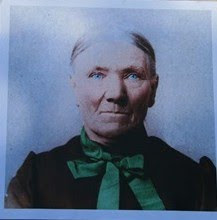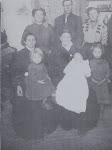Historic Marker located in Dayton, Idaho
In 1867 Joseph Chadwick and family (Sarah Goode Marshall Chadwick) settled on Five Mile Creek and built a log cabin. In one room he had a supply store to accommodate the few settlers and freighters. He was followed by Peter Poole, Robert Taylor, Stephen Callan, George Mendenhall, Richard Wickham and their families. The locality was originally known as Five Mile, later Chadville, and in 1890 Card. In 1906 Wm. B. Preston gave it the name of Dayton. Fred Jenson was the first L.D.S. Presiding Elder.
Historical Marker Dayton, Idaho
Other Dayton Idaho Histories:
Dayton a town of about two hundred inhabitants, located across Bear River, west and about five miles from Preston. Is now a productive center for sugar beets, alfalfa, dairying and poultry.
Settlers: -- This town was settled first by Joseph Chadwick and family, who settled on Five Mile Creek in 1867. He built a log house, which is still standing. Shortly afterwards he was joined by Peter Poole, Robert Taylor, Stephen Callan and Richard Wickham.
Name: --The place was first called “Chadville” then “Five Miles” (it being just five miles from Weston and five miles from Clifton.) It was later called Dayton.
First Born: -- The boy and girl having the honor of being the first-born were Alfred Wickham and Sarah Spackman.
Business Houses: -- Joseph Chadwick, the first settler, opened up a supply store in the north room of his home for the accommodation of the few settlers and freights going through. The next to open up places for buiness were: F. B. Wooley, Phillips and Atkinson, Paul Larsen, Doren Perkins and P. Jones.
Postmasters: --The following have served as postmasters: Garett Campbell, Niels Michelson, F.O. Hales, and J. H. Schow, B. A. Johnson and Mary Smith.
Church Organizations
Buildings: -- The settlers first belonged to the Weston ward, presided over by Bishop Henry Jensen. A log house was brought from Weston to Dayton and served for meetings and school. Miss Annie Boden served as the schoolteacher in the log house.
This log building was soon replaced by a two-room frame building, which served as a community center, until 1909, when the present L.D.S. church was built (recently the building was remodeled and provided with class rooms, and a modern heating system).
In 1914, a modern six-room school building was erected; it is provided with a full basement providing a gymnasium.
As the number of settlers increased the town was organized into a ward. Stephen Callan was appointed to act as the first presiding elder. The bishops in their order were. Philo W. Austin, S. J. Callan, Alma L. Hansen and Charles Jones.
The first Relef Society was organized with Mrs. Louise Boyce as President. Mrs. Sarah P. Callan was President of the Y.M.M.I.A., and Luna Nelson Chadwick, President of the first primary.
Railroad: -- 1890, the Oregon Short Line Railroad first passed through Dayton. A flag station “card” served the town until 1906 when a substantial station was built and designated as Dayton. Due to the central location of this town all trains stop here regularly.
(Taken from THE TRAILBLAZER published 1930)
About Dayton
Dayton is situated at the base of the Bannock Mountains, on the west side of Cache Valley, and at the mouth of Five Mile Canyon. The mountains reach to elevations above 6,000 feet just a few miles west of town, compared with 4,818 at Dayton itself. Grass and sagebrush and farmland cover the slopes next to Dayton, with junipers and other trees on the higher slopes. The valley, stretching for miles to the north, east and south, is an important agricultural region, checkered with fields, and dotted with houses. The Bear River passes a few miles to the east.
Dayton is a tiny town, with just two streets running north and south and a few cross streets. State Highway 36 meets the Westside Highway at the main intersection in town. The Westside Highway goes north and south from Dayton, following the base of the mountains. State Highway 36 crosses the valley eastward to reach Preston. At Dayton, it turns south and shares the route with the Westside Highway. Five Mile Road is a dirt road that climbs Five Mile Canyon.
The first settler at Dayton was Joseph Chadwick and his family, who built a log cabin on Five Mile Creek in 1867. The town was called Five Mile Creek, then Chadville and Card. It received its present name in 1906. The population, as of 2000, is 444.
For Photos see March 2010 Archives
















DAYTON
ReplyDeleteIn 1867, Joseph Chadwick settled near Five Mile
Creek, the present site of Dayton. Soon after his arrival, Chadwick was joined by other families. The new settlers called their new home Five Mile because it was five miles
to Weston on the south and five miles to Clifton on the North. Later, to honor its first settler, the name was changed to Chadville. Then the community was known as Card. Finally, Dayton was named by Cache Valley church leader William B. Preston, who said whenever he visited the community he always seemed to arrive in the day time. Most of the early residents of Dayton were farmers who planted various drops or managed dairy herds. At one time the village maintained a small herd of
elk which attracted many tourists and much later some residents raised and sold Christmas trees.
HERITAGE SIGHTS: Settlers Marker, 1000 N. west side of Hwy 81; Harold B. Lee School.